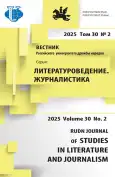TV Talk Shows and Electoral Outcome: Branding Russian Political Parties
- Authors: Dolgova Y.I.1, Sazhina V.V.2, Algavi L.O.3
-
Affiliations:
- Lomonosov Moscow State University
- Communication University of China
- RUDN University
- Issue: Vol 30, No 2 (2025)
- Pages: 376-389
- Section: JOURNALISM
- URL: https://journal-vniispk.ru/2312-9220/article/view/319135
- DOI: https://doi.org/10.22363/2312-9220-2025-30-2-376-389
- EDN: https://elibrary.ru/KAPMNN
- ID: 319135
Cite item
Full Text
Abstract
Reviewed to the impact of TV talk shows on the perception of political party brands in Russia. Research focuses on the methods of brand development and promotion of political party brands in Russia, particularly through socio-political talk shows on television. We conducted a longitudinal comparative analysis of the media representation of deputies from various parties in 2019 and 2021, along with a qualitative study of politicians’ performances in 2023 across three federal channels: Channel One, Russia 1, and NTV . Based on our findings, we propose a two-stage model for analyzing the branding of politicians in television broadcasts. The study found that socio-political talk shows have a significant impact on both personal and political image formation. However, not all political parties take advantage of this opportunity to promote their image through broadcasts. The availability of administrative resources is not always a determining factor in a party’s success in branding. This work aims to enhance the understanding of the mechanisms involved in political promotion and branding, which is especially pertinent to Russian political practice as we approach the next electoral cycle. In light of this, the article underscores the necessity for further research to refine communication strategies between political parties and the public.
About the authors
Yulia I. Dolgova
Lomonosov Moscow State University
Email: YIDolgova@gmail.com
ORCID iD: 0000-0001-8861-0521
SPIN-code: 1595-6606
PhD in Philology, Associate Professor of the Department of Television and Radio, Faculty of Journalism
9 Mokhovaya St, bldg 1, Moscow, 125009, Russian FederationVioletta V. Sazhina
Communication University of China
Email: violetsvz@gmail.com
ORCID iD: 0009-0000-4613-6585
Student of School of Drama, TV and Cinematic Arts, Communication
1 Dingfuzhuang East St, bldg 21, Office C103, Chaoyang District, Beijing, 100024, People's Republic of ChinaLeila O. Algavi
RUDN University
Author for correspondence.
Email: algawy_lo@rudn.ru
ORCID iD: 0000-0001-5335-8506
SPIN-code: 1165-8610
PhD in Philology, Associate Professor of the Department of of Theory and History of Journalism, Faculty of Philology
10 Miklukho-Maklaya St, bldg 2, Moscow, 117198, Russian FederationReferences
- Aksenov, A.A. (2013). Advertising in Politics. Komsomolsk-na-Amure State University Publ. (In Russ.)
- Dolgova, Yu.I., Peripechina, G.V., & Tichonova, O.V. (2019). Content Strategies of the Big Three TV Channels: Topics, Genres, Formats. Tomsk State University Journal of Philology, 61, 237–255. (In Russ.) https://doi.org/10.17223/19986645/61/14
- Fedorov, V.V. (2006). Political Dictionary of Our Time. Moscow: VCIOM Publ. (In Russ.)
- Gladilin, A.V. (2013). Hate speech in Traditional and New Media. Bulletin of Chelyabinsk State University, 21(312), 144–153. (In Russ.)
- Grinberg, T.E. (2012). Political Technologies: PR and Advertising. Moscow: Aspect Press Publ. (In Russ.)
- Gugnin, A.M. (2016). Political Marketing (essence and genesis). Philosophy and Society, 2(79), 84–89. (In Russ.)
- Gulenko, P. (2021). Political Discussion as a Propaganda Spectacle: Propaganda Talk Shows on Contemporary Russian Television. Media, Culture & Society, 43(5), 906–924. https://
- doi.org/10.1177/0163443720974230
- Gulenko, P., & Dolgova, Yu. (2020). Evolution of interactive elements in socio-political talk shows in post-Soviet Russia. Global Media and Communication, 17(1), 25–43. https://
- doi.org/10.1177/1742766520946471
- Ilyasov, F.N. (2000). Political Marketing. The Art and Science of Winning Elections. Moscow: IMA-Press Publ. (In Russ.)
- Kuznetsov, G.V. (2004). TV Journalist Work This Way. Moscow State University Publ. (In Russ.)
- Meshcheryakov, B., & Zinchenko, V. (2004). Great psychological dictionary. Moscow: Olma-press Publ. (In Russ.)
- Myakotina, O.V. (2008). The Image of a Political Leader: Formation Trends and Changes [Doctoral Dissertation, Moscow State Region University]. Moscow. (In Russ.)
- Nedyak, I.L. (2010). Political Marketing: Features of the Development of the Research Area. Polis, 3, 144–155. (In Russ.)
- Pich, C., & Newman, B.I. (2019). Evolution of Political Branding: Typologies, Diverse Settings and Future Research. Journal of Political Marketing, 19(1–2), 3–14. https://doi.org/10.1080/15377857.2019.1680932
- Pimenov, N.P. (2016). The Crisis of Non-System Opposition: A Trend or an Accident? Discourse, (1), 84–92. (In Russ.)
- Pokrishchuk, D.V. (2008). Political Marketing: On Some Aspects of Russian and Foreign Experience. Izvestia: Herzen University Journal of Humanities & Sciences, 82(38-1), 284–289. (In Russ.)
- Rogach, N.N. (2021). Russian Citizens’ Perception of Ideal Politicians: Comparative Analysis of the Images. Political Expertise: POLITEX, 17(4), 406–418. (In Russ.) https://doi.org/10.21638/spbu23.2021.406
- Rudenko, A.F. (2013). Party Brands on the Political Markets of Russia and Ukraine. Youth World Politics, (4), 82–89. (In Russ.)
- Segela, J. (1999). National Peculiarities of Hunting for Votes. Moscow: Vagrius Publ. (In Russ.)
- Skvortsova N., Abazov D., Volkova I., & Urazova S. (2023). Georgian Independent TV Channels: Presentation of Pre-Election Race. International Journal of Media and Information Literacy, 8(2), 416–426. https://doi.org/10.13187/ijmil.2023.2.416
Supplementary files









